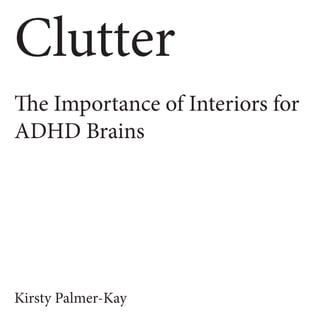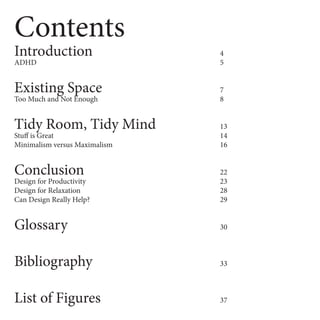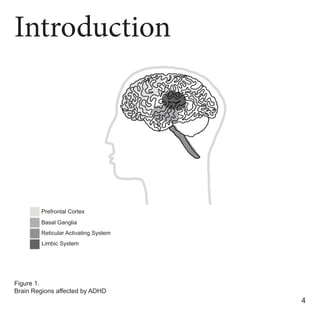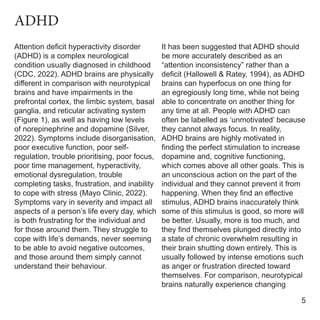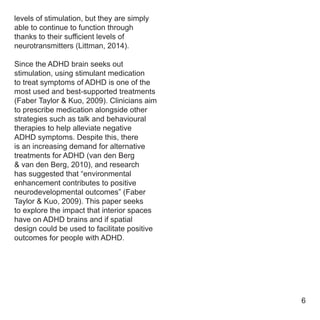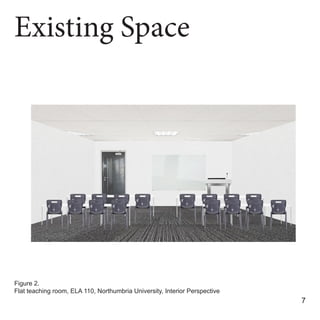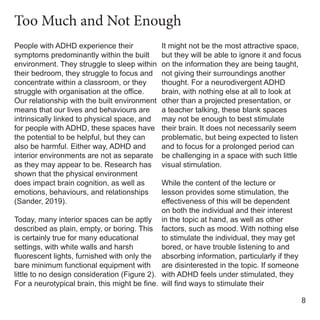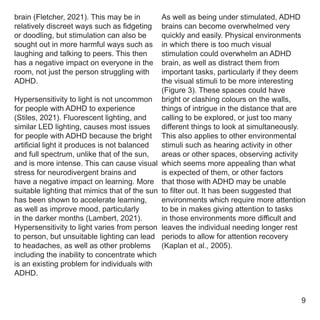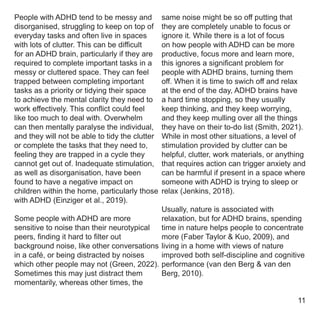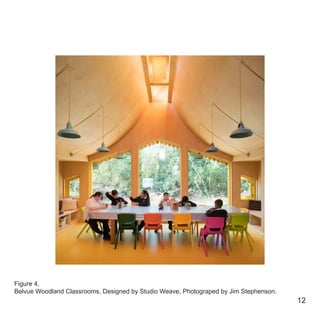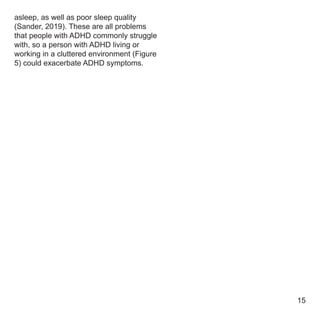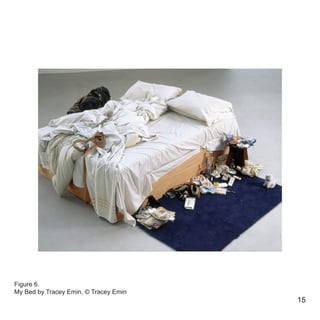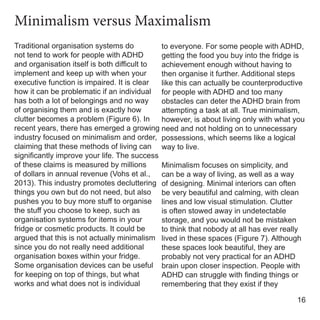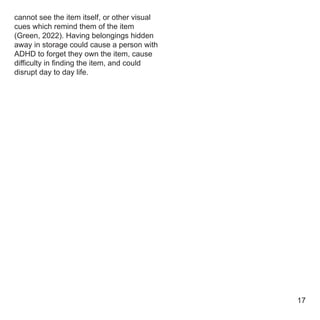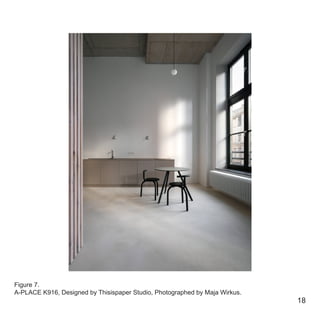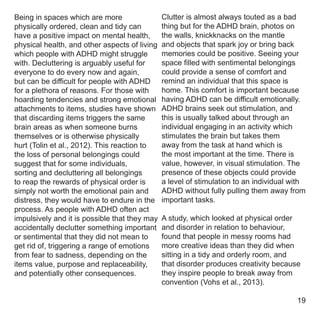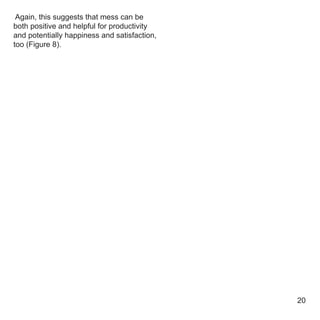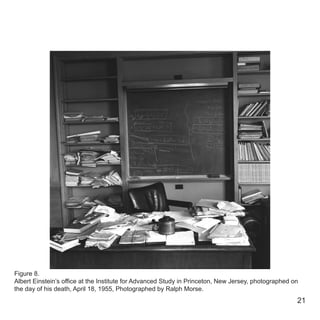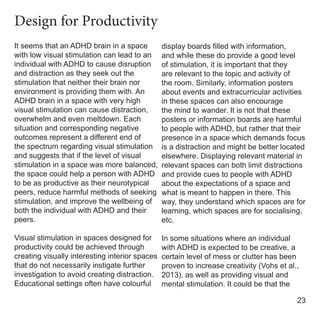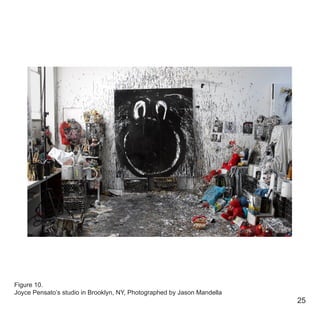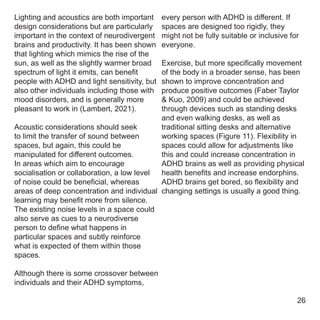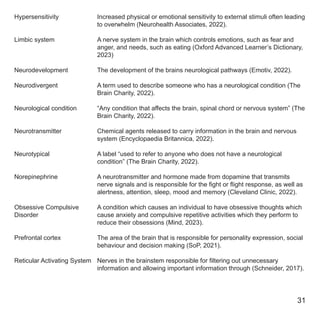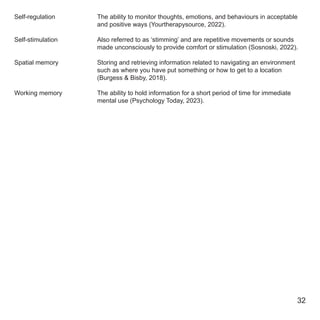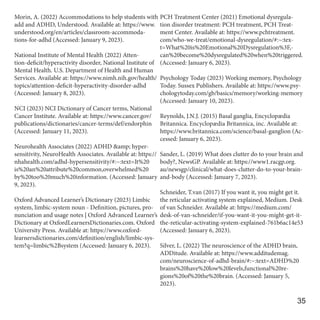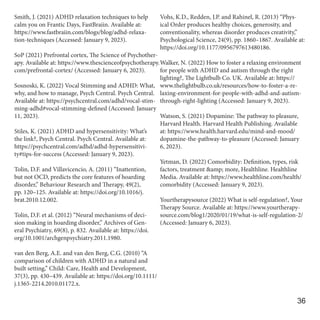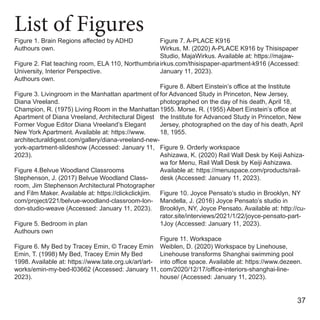Kirtsty Palmer Clay - Clutter, adhd and interiors
- 1. Clutter The Importance of Interiors for ADHD Brains Kirsty Palmer-Kay
- 2. Contents Introduction 4 ADHD 5 Existing Space 7 Too Much and Not Enough 8 Tidy Room, Tidy Mind 13 Stuff is Great 14 Minimalism versus Maximalism 16 Conclusion 22 Design for Productivity 23 Design for Relaxation 28 Can Design Really Help? 29 Glossary 30 Bibliography 33 List of Figures 37
- 3. Introduction Prefrontal Cortex Basal Ganglia Reticular Activating System Limbic System 4 Figure 1. Brain Regions affected by ADHD
- 4. Attention deficit hyperactivity disorder (ADHD) is a complex neurological condition usually diagnosed in childhood (CDC, 2022). ADHD brains are physically different in comparison with neurotypical brains and have impairments in the prefrontal cortex, the limbic system, basal ganglia, and reticular activating system (Figure 1), as well as having low levels of norepinephrine and dopamine (Silver, 2022). Symptoms include disorganisation, poor executive function, poor self- regulation, trouble prioritising, poor focus, poor time management, hyperactivity, emotional dysregulation, trouble completing tasks, frustration, and inability to cope with stress (Mayo Clinic, 2022). Symptoms vary in severity and impact all aspects of a personŌĆÖs life every day, which is both frustrating for the individual and for those around them. They struggle to cope with lifeŌĆÖs demands, never seeming to be able to avoid negative outcomes, and those around them simply cannot understand their behaviour. It has been suggested that ADHD should be more accurately described as an ŌĆ£attention inconsistencyŌĆØ rather than a deficit (Hallowell & Ratey, 1994), as ADHD brains can hyperfocus on one thing for an egregiously long time, while not being able to concentrate on another thing for any time at all. People with ADHD can often be labelled as ŌĆśunmotivatedŌĆÖ because they cannot always focus. In reality, ADHD brains are highly motivated in finding the perfect stimulation to increase dopamine and, cognitive functioning, which comes above all other goals. This is an unconscious action on the part of the individual and they cannot prevent it from happening. When they find an effective stimulus, ADHD brains inaccurately think some of this stimulus is good, so more will be better. Usually, more is too much, and they find themselves plunged directly into a state of chronic overwhelm resulting in their brain shutting down entirely. This is usually followed by intense emotions such as anger or frustration directed toward themselves. For comparison, neurotypical brains naturally experience changing 5 ADHD
- 5. levels of stimulation, but they are simply able to continue to function through thanks to their sufficient levels of neurotransmitters (Littman, 2014). Since the ADHD brain seeks out stimulation, using stimulant medication to treat symptoms of ADHD is one of the most used and best-supported treatments (Faber Taylor & Kuo, 2009). Clinicians aim to prescribe medication alongside other strategies such as talk and behavioural therapies to help alleviate negative ADHD symptoms. Despite this, there is an increasing demand for alternative treatments for ADHD (van den Berg & van den Berg, 2010), and research has suggested that ŌĆ£environmental enhancement contributes to positive neurodevelopmental outcomesŌĆØ (Faber Taylor & Kuo, 2009). This paper seeks to explore the impact that interior spaces have on ADHD brains and if spatial design could be used to facilitate positive outcomes for people with ADHD. 6
- 6. Existing Space 7 Figure 2. Flat teaching room, ELA 110, Northumbria University, Interior Perspective
- 7. People with ADHD experience their symptoms predominantly within the built environment. They struggle to sleep within their bedroom, they struggle to focus and concentrate within a classroom, or they struggle with organisation at the office. Our relationship with the built environment means that our lives and behaviours are intrinsically linked to physical space, and for people with ADHD, these spaces have the potential to be helpful, but they can also be harmful. Either way, ADHD and interior environments are not as separate as they may appear to be. Research has shown that the physical environment does impact brain cognition, as well as emotions, behaviours, and relationships (Sander, 2019). Today, many interior spaces can be aptly described as plain, empty, or boring. This is certainly true for many educational settings, with white walls and harsh fluorescent lights, furnished with only the bare minimum functional equipment with little to no design consideration (Figure 2). For a neurotypical brain, this might be fine. It might not be the most attractive space, but they will be able to ignore it and focus on the information they are being taught, not giving their surroundings another thought. For a neurodivergent ADHD brain, with nothing else at all to look at other than a projected presentation, or a teacher talking, these blank spaces may not be enough to best stimulate their brain. It does not necessarily seem problematic, but being expected to listen and to focus for a prolonged period can be challenging in a space with such little visual stimulation. While the content of the lecture or lesson provides some stimulation, the effectiveness of this will be dependent on both the individual and their interest in the topic at hand, as well as other factors, such as mood. With nothing else to stimulate the individual, they may get bored, or have trouble listening to and absorbing information, particularly if they are disinterested in the topic. If someone with ADHD feels under stimulated, they will find ways to stimulate their 8 Too Much and Not Enough
- 8. brain (Fletcher, 2021). This may be in relatively discreet ways such as fidgeting or doodling, but stimulation can also be sought out in more harmful ways such as laughing and talking to peers. This then has a negative impact on everyone in the room, not just the person struggling with ADHD. Hypersensitivity to light is not uncommon for people with ADHD to experience (Stiles, 2021). Fluorescent lighting, and similar LED lighting, causes most issues for people with ADHD because the bright artificial light it produces is not balanced and full spectrum, unlike that of the sun, and is more intense. This can cause visual stress for neurodivergent brains and have a negative impact on learning. More suitable lighting that mimics that of the sun has been shown to accelerate learning, as well as improve mood, particularly in the darker months (Lambert, 2021). Hypersensitivity to light varies from person to person, but unsuitable lighting can lead to headaches, as well as other problems including the inability to concentrate which is an existing problem for individuals with ADHD. As well as being under stimulated, ADHD brains can become overwhelmed very quickly and easily. Physical environments in which there is too much visual stimulation could overwhelm an ADHD brain, as well as distract them from important tasks, particularly if they deem the visual stimuli to be more interesting (Figure 3). These spaces could have bright or clashing colours on the walls, things of intrigue in the distance that are calling to be explored, or just too many different things to look at simultaneously. This also applies to other environmental stimuli such as hearing activity in other areas or other spaces, observing activity which seems more appealing than what is expected of them, or other factors that those with ADHD may be unable to filter out. It has been suggested that environments which require more attention to be in makes giving attention to tasks in those environments more difficult and leaves the individual needing longer rest periods to allow for attention recovery (Kaplan et al., 2005). 9
- 9. 10 Figure 3. Livingroom in the Manhattan apartment of Diana Vreeland. Designed by Billy Baldwin. Photographed by Richard Champion.
- 10. same noise might be so off putting that they are completely unable to focus or ignore it. While there is a lot of focus on how people with ADHD can be more productive, focus more and learn more, this ignores a significant problem for people with ADHD brains, turning them off. When it is time to swich off and relax at the end of the day, ADHD brains have a hard time stopping, so they usually keep thinking, and they keep worrying, and they keep mulling over all the things they have on their to-do list (Smith, 2021). While in most other situations, a level of stimulation provided by clutter can be helpful, clutter, work materials, or anything that requires action can trigger anxiety and can be harmful if present in a space where someone with ADHD is trying to sleep or relax (Jenkins, 2018). Usually, nature is associated with relaxation, but for ADHD brains, spending time in nature helps people to concentrate more (Faber Taylor & Kuo, 2009), and living in a home with views of nature improved both self-discipline and cognitive performance (van den Berg & van den Berg, 2010). People with ADHD tend to be messy and disorganised, struggling to keep on top of everyday tasks and often live in spaces with lots of clutter. This can be difficult for an ADHD brain, particularly if they are required to complete important tasks in a messy or cluttered space. They can feel trapped between completing important tasks as a priority or tidying their space to achieve the mental clarity they need to work effectively. This conflict could feel like too much to deal with. Overwhelm can then mentally paralyse the individual, and they will not be able to tidy the clutter or complete the tasks that they need to, feeling they are trapped in a cycle they cannot get out of. Inadequate stimulation, as well as disorganisation, have been found to have a negative impact on children within the home, particularly those with ADHD (Einziger et al., 2019). Some people with ADHD are more sensitive to noise than their neurotypical peers, finding it hard to filter out background noise, like other conversations in a caf├®, or being distracted by noises which other people may not (Green, 2022). Sometimes this may just distract them momentarily, whereas other times, the 11
- 11. 12 Figure 4. Belvue Woodland Classrooms, Designed by Studio Weave, Photograped by Jim Stephenson.
- 12. Tidy Room, Tidy Mind 13 Figure 5. Bedroom in plan
- 13. It is common for people with ADHD to own many belongings and live in spaces filled with lots of stuff. A key symptom of ADHD is impulsivity and can include impulsive spending. Impaired executive functioning results in some people with ADHD buying things they want when they see them (Low, 2020), without considering what they already have or if they really need something new. The act of shopping often provides the dopamine rush that ADHD brains crave which in the moment is hard to resist. It has been said that ŌĆ£Individuals with ADHD experience life more intensely than neurotypicalsŌĆØ (Dodson, 2021). This intensity includes emotions and feelings about sentimentality, which can make getting rid of stuff more difficult as they feel connected to the things they own and feel guilty about getting rid of things they might not need because it was given to them by someone they care about or is tied to a memory (Maynard, 2020). Hoarding has traditionally been associated with OCD (obsessive compulsive disorder), but research is beginning to suggest that hoarding is more closely related with ADHD (Tolin & Villavicencio, 2011). Not everyone with ADHD has hoarding disorder as a comorbidity, but it is thought that 1 in 5 adults with ADHD have significant hoarding symptoms (Anglia Ruskin University, 2022). It has been suggested that those with ADHD have similar traits to those with hoarding disorder such as difficulty discarding, the acquisition of clutter, poor organisation, poor long-term planning, poor spatial and working memory, attention problems and deficits in executive functioning (Hacker et al., 2016). Being surrounded by clutter has been proven to increase anxiety and decrease a personŌĆÖs overall satisfaction with life, leading to cognitive overload which reduces both the working memory and the ability to focus. Sleeping in a cluttered room can also lead to problems falling 14 Stuff is Great
- 14. asleep, as well as poor sleep quality (Sander, 2019). These are all problems that people with ADHD commonly struggle with, so a person with ADHD living or working in a cluttered environment (Figure 5) could exacerbate ADHD symptoms. 15
- 15. 15 Figure 6. My Bed by Tracey Emin, ┬® Tracey Emin
- 16. Traditional organisation systems do not tend to work for people with ADHD and organisation itself is both difficult to implement and keep up with when your executive function is impaired. It is clear how it can be problematic if an individual has both a lot of belongings and no way of organising them and is exactly how clutter becomes a problem (Figure 6). In recent years, there has emerged a growing industry focused on minimalism and order, claiming that these methods of living can significantly improve your life. The success of these claims is measured by millions of dollars in annual revenue (Vohs et al., 2013). This industry promotes decluttering things you own but do not need, but also pushes you to buy more stuff to organise the stuff you choose to keep, such as organisation systems for items in your fridge or cosmetic products. It could be argued that this is not actually minimalism since you do not really need additional organisation boxes within your fridge. Some organisation devices can be useful for keeping on top of things, but what works and what does not is individual to everyone. For some people with ADHD, getting the food you buy into the fridge is achievement enough without having to then organise it further. Additional steps like this can actually be counterproductive for people with ADHD and too many obstacles can deter the ADHD brain from attempting a task at all. True minimalism, however, is about living only with what you need and not holding on to unnecessary possessions, which seems like a logical way to live. Minimalism focuses on simplicity, and can be a way of living, as well as a way of designing. Minimal interiors can often be very beautiful and calming, with clean lines and low visual stimulation. Clutter is often stowed away in undetectable storage, and you would not be mistaken to think that nobody at all has ever really lived in these spaces (Figure 7). Although these spaces look beautiful, they are probably not very practical for an ADHD brain upon closer inspection. People with ADHD can struggle with finding things or remembering that they exist if they 16 Minimalism versus Maximalism
- 17. cannot see the item itself, or other visual cues which remind them of the item (Green, 2022). Having belongings hidden away in storage could cause a person with ADHD to forget they own the item, cause difficulty in finding the item, and could disrupt day to day life. 17
- 18. 18 Figure 7. A-PLACE K916, Designed by Thisispaper Studio, Photographed by Maja Wirkus.
- 19. Clutter is almost always touted as a bad thing but for the ADHD brain, photos on the walls, knickknacks on the mantle and objects that spark joy or bring back memories could be positive. Seeing your space filled with sentimental belongings could provide a sense of comfort and remind an individual that this space is home. This comfort is important because having ADHD can be difficult emotionally. ADHD brains seek out stimulation, and this is usually talked about through an individual engaging in an activity which stimulates the brain but takes them away from the task at hand which is the most important at the time. There is value, however, in visual stimulation. The presence of these objects could provide a level of stimulation to an individual with ADHD without fully pulling them away from important tasks. A study, which looked at physical order and disorder in relation to behaviour, found that people in messy rooms had more creative ideas than they did when sitting in a tidy and orderly room, and that disorder produces creativity because they inspire people to break away from convention (Vohs et al., 2013). Being in spaces which are more physically ordered, clean and tidy can have a positive impact on mental health, physical health, and other aspects of living which people with ADHD might struggle with. Decluttering is arguably useful for everyone to do every now and again, but can be difficult for people with ADHD for a plethora of reasons. For those with hoarding tendencies and strong emotional attachments to items, studies have shown that discarding items triggers the same brain areas as when someone burns themselves or is otherwise physically hurt (Tolin et al., 2012). This reaction to the loss of personal belongings could suggest that for some individuals, sorting and decluttering all belongings to reap the rewards of physical order is simply not worth the emotional pain and distress, they would have to endure in the process. As people with ADHD often act impulsively and it is possible that they may accidentally declutter something important or sentimental that they did not mean to get rid of, triggering a range of emotions from fear to sadness, depending on the items value, purpose and replaceability, and potentially other consequences. 19
- 20. Again, this suggests that mess can be both positive and helpful for productivity and potentially happiness and satisfaction, too (Figure 8). 20
- 21. 21 Figure 8. Albert EinsteinŌĆÖs office at the Institute for Advanced Study in Princeton, New Jersey, photographed on the day of his death, April 18, 1955, Photographed by Ralph Morse.
- 22. Conclusion 22 Figure 9. Orderly workspace, Desk designed by Keiji Ashizawa.
- 23. It seems that an ADHD brain in a space with low visual stimulation can lead to an individual with ADHD to cause disruption and distraction as they seek out the stimulation that neither their brain nor environment is providing them with. An ADHD brain in a space with very high visual stimulation can cause distraction, overwhelm and even meltdown. Each situation and corresponding negative outcomes represent a different end of the spectrum regarding visual stimulation and suggests that if the level of visual stimulation in a space was more balanced, the space could help a person with ADHD to be as productive as their neurotypical peers, reduce harmful methods of seeking stimulation, and improve the wellbeing of both the individual with ADHD and their peers. Visual stimulation in spaces designed for productivity could be achieved through creating visually interesting interior spaces that do not necessarily instigate further investigation to avoid creating distraction. Educational settings often have colourful display boards filled with information, and while these do provide a good level of stimulation, it is important that they are relevant to the topic and activity of the room. Similarly, information posters about events and extracurricular activities in these spaces can also encourage the mind to wander. It is not that these posters or information boards are harmful to people with ADHD, but rather that their presence in a space which demands focus is a distraction and might be better located elsewhere. Displaying relevant material in relevant spaces can both limit distractions and provide cues to people with ADHD about the expectations of a space and what is meant to happen in there. This way, they understand which spaces are for learning, which spaces are for socialising, etc. In some situations where an individual with ADHD is expected to be creative, a certain level of mess or clutter has been proven to increase creativity (Vohs et al., 2013), as well as providing visual and mental stimulation. It could be that the 23 Design for Productivity
- 24. benefits of clutter can be seen when the clutter is related to the task, rather than general clutter. For example, a design student with ADHD working more creatively and effectively in their university studio at a messy desk which is cluttered with pens and pencils, past works, half-finished drawings, scraps of paper to scribble down ideas, books filled with inspiration, etc. The same student working at home in their bedroom where there is also a pile of laundry to put away, clothes to wash, belongings spilled out across the floor and every possible surface, a pile of personal admin tasks to complete, etc, may not work more creatively. Although there is clutter in both scenarios, the type of clutter is different. The clutter at home serves as a visual to-do list, and is a distraction from the creative process, while the clutter on their desk inspires freedom and creativity. While visual stimulation is important and can lead to positive outcomes, it is essential that the right type of stimulation is provided in the right setting. The positive benefits of green space on cognition suggests that a connection to the outside is beneficial for ADHD productivity, and can help to provide stimulation in spaces. Research into order and disorder has also shown that productivity can be achieved in a highly ordered space, but that working in these spaces produces outcomes which conform to societal expectations and linear thinking (Vohs et al., 2013). This could also support the idea that spaces can be manipulated to produce desired outcomes and behaviours. Learning about maths where answers are either right or wrong in a highly ordered space (Figure 9) could be the most effective environment for this to happen in but engaging in art class in a more disorganised space (Figure 10) could be the most effective environment for this activity. 24
- 25. 25 Figure 10. Joyce PensatoŌĆÖs studio in Brooklyn, NY, Photographed by Jason Mandella
- 26. every person with ADHD is different. If spaces are designed too rigidly, they might not be fully suitable or inclusive for everyone. Exercise, but more specifically movement of the body in a broader sense, has been shown to improve concentration and produce positive outcomes (Faber Taylor & Kuo, 2009) and could be achieved through devices such as standing desks and even walking desks, as well as traditional sitting desks and alternative working spaces (Figure 11). Flexibility in spaces could allow for adjustments like this and could increase concentration in ADHD brains as well as providing physical health benefits and increase endorphins. ADHD brains get bored, so flexibility and changing settings is usually a good thing. Lighting and acoustics are both important design considerations but are particularly important in the context of neurodivergent brains and productivity. It has been shown that lighting which mimics the rise of the sun, as well as the slightly warmer broad spectrum of light it emits, can benefit people with ADHD and light sensitivity, but also other individuals including those with mood disorders, and is generally more pleasant to work in (Lambert, 2021). Acoustic considerations should seek to limit the transfer of sound between spaces, but again, this could be manipulated for different outcomes. In areas which aim to encourage socialisation or collaboration, a low level of noise could be beneficial, whereas areas of deep concentration and individual learning may benefit more from silence. The existing noise levels in a space could also serve as cues to a neurodiverse person to define what happens in particular spaces and subtly reinforce what is expected of them within those spaces. Although there is some crossover between individuals and their ADHD symptoms, 26
- 27. 27 Figure 11. Workspace, Designed by Linehouse, Photographed by Dirk Weiblen.
- 28. Productivity without relaxation leads to burnout, so the ability to unwind is essential to sustain productivity. Unfortunately, ADHD brains also struggle to switch off and to sleep. Relaxation is best achieved in calm spaces with low levels of visual stimulation. The problem with this is that people generally tend to relax and sleep within their homes, the same homes that are usually cluttered. Clutter is not inherently bad, but may serve an individual better if it is not present in rooms designed for relaxation and unwinding, to avoid encouraging the ADHD brain to work overtime. People with ADHD can feel emotions more intensely than their neurotypical peers, particularly negative emotions. They can also feel misunderstood and left out and have strong emotional reactions to these feelings. The presence of their belongings in their own home could act as somewhat of a comfort blanket when everything gets a bit too much, signifying that they are safe in this space and reinforcing their sense of self and place in the world. This comfort could be relaxing and could again be a visual cue to remind them that, despite the way they feel, they are home and everything is okay. Despite this, excessive clutter may be better suited to areas of productivity or general living spaces, where they can still seek comfort from them, but having a dedicated space to truly relax and switch off is important. Lighting which focuses on the natural cycle of the sunset can have positive impacts on sleep and relaxation. It can help with body clock regulation, and can provide a visual cue that signifies that it is time to unwind. A space for relaxation will look different for everyone, but maybe this is an appropriate space to embrace minimalism. 28 Design for Relaxation
- 29. It is not fully known what specific elements of spatial design are beneficial to ADHD brains and is an area which requires more research to fully understand how spatial considerations can best support ADHD brains. Existing research explored within this paper suggests that spaces can be enhanced and manipulated to produce required or desirable outcomes. Physical order to create linear thinking, messy workspaces for creativity, sentimental clutter for comfort, creative clutter for productivity, minimalism for relaxation, lighting to improve mood and cognition, lighting to aid sleep, green space to enhance positive behaviours, visual stimulation in interiors to prevent harmful behaviours and increase productivity. Interiors can be used to provide environmental cues to signify to an ADHD brain what is acceptable and expected within particular spaces and can limit the discomfort an ADHD brain might feel as a result of environmental stimuli. It has shown that flexibility is important because every ADHD brain is different, but that designing with the ADHD brain in mind does not come at the detriment of neurotypical brains. In the debate of minimalism vs maximalism it has shown that there is room for both, and that maybe two opposing concepts can come together to support the ADHD in different and unexpected ways. Ultimately, it seems that the ADHD brain really does respond to the environment around it, and that when it is in the right place at the right time, interior spaces can support the ADHD mind to work well. The way space is designed is by no means going to mitigate all symptoms of ADHD for every person with ADHD, but its impact is measurable and should be considered by healthcare professionals as something which could improve negative symptoms alongside other medical interventions. Interior architects, architects and interior designers alike should consider the way they design for people with ADHD and strive to make more spaces accessible for neurodivergent brains. More research is needed to determine specific ways spatial design can support ADHD brains. 29 Can Design Really Help?
- 30. Glossary Basal Ganglia Cognitive Functioning Comorbidity Dopamine Emotional Dysregulation Endorphins Executive function Hoarding disorder Hyperactivity Hyperfocus A group of neuron clusters in the brain responsible for movement, response to stimuli, planning and learning (Reynolds, 2015). Performing mental processes such as learning, awareness, understanding, perception, memory, reasoning, language, judgement, and intuition (APA Dictionary of Psychology, 2022). A comorbidity is a condition which exists alongside another condition (Yetman, 2022). A neurotransmitter which is released as a result of pleasurable experiences (Watson, 2021). A person being unable to control or regulate their emotional responses in an appropriate or expected way (PCH Treatment Center, 2021). A neurotransmitter within the body found to reduce pain and produce feelings of happiness and wellbeing (NCI, 2023). A set of mental skills that allow people to navigate everyday life including working memory, flexible thinking and self-control (Belksy, 2022). A mental health condition where someone feels the strong urge to save many items regardless of their monetary value (Cleveland Clinic, 2022). In ADHD, hyperactivity can mean moving around a lot, fidgeting, tapping, talking too much or restlessness (National Institute of Mental Health, 2022). ŌĆ£Complete absorption in a task to a point where a person appears to completely ignore or ŌĆśtune outŌĆÖ everything elseŌĆØ. The task is usually enjoyable for the person (Ashinoff & Abu-Akel, 2019). 30
- 31. Hypersensitivity Limbic system Neurodevelopment Neurodivergent Neurological condition Neurotransmitter Neurotypical Norepinephrine Obsessive Compulsive Disorder Prefrontal cortex Reticular Activating System Increased physical or emotional sensitivity to external stimuli often leading to overwhelm (Neurohealth Associates, 2022). A nerve system in the brain which controls emotions, such as fear and anger, and needs, such as eating (Oxford Advanced LearnerŌĆÖs Dictionary, 2023) The development of the brains neurological pathways (Emotiv, 2022). A term used to describe someone who has a neurological condition (The Brain Charity, 2022). ŌĆ£Any condition that affects the brain, spinal chord or nervous systemŌĆØ (The Brain Charity, 2022). Chemical agents released to carry information in the brain and nervous system (Encyclopaedia Britannica, 2022). A label ŌĆ£used to refer to anyone who does not have a neurological conditionŌĆØ (The Brain Charity, 2022). A neurotransmitter and hormone made from dopamine that transmits nerve signals and is responsible for the fight or flight response, as well as alertness, attention, sleep, mood and memory (Cleveland Clinic, 2022). A condition which causes an individual to have obsessive thoughts which cause anxiety and compulsive repetitive activities which they perform to reduce their obsessions (Mind, 2023). The area of the brain that is responsible for personality expression, social behaviour and decision making (SoP, 2021). Nerves in the brainstem responsible for filtering out unnecessary information and allowing important information through (Schneider, 2017). 31
- 32. Self-regulation Self-stimulation Spatial memory Working memory The ability to monitor thoughts, emotions, and behaviours in acceptable and positive ways (Yourtherapysource, 2022). Also referred to as ŌĆśstimmingŌĆÖ and are repetitive movements or sounds made unconsciously to provide comfort or stimulation (Sosnoski, 2022). Storing and retrieving information related to navigating an environment such as where you have put something or how to get to a location (Burgess & Bisby, 2018). The ability to hold information for a short period of time for immediate mental use (Psychology Today, 2023). 32
- 33. Bibliography Anglia Ruskin University (2022) ADHD linked to hoarding behavior, ScienceDaily. ScienceDaily. Available at: https://www.sciencedaily.com/releas- es/2022/02/220225135652.htm#:~:text=%22ADHD%20 linked%20to%20hoarding%20behavior,ScienceDai- ly%2C%2025%20February%202022. (Accessed: January 7, 2023). APA Dictionary of Psychology (2022) Apa Dictionary of Psychology, American Psychological Association. American Psychological Association. Available at: https:// dictionary.apa.org/cognitive-functioning (Accessed: January 6, 2023). Ashinoff, B.K. and Abu-Akel, A. (2019) ŌĆ£Hyperfocus: The Forgotten Frontier of Attention,ŌĆØ Psychological Research, 85(1), pp. 1ŌĆō19. Available at: https://doi.org/10.1007/ s00426-019-01245-8. Belsky, G. (2022) What is executive function?, Under- stood. Understood for All Inc. Available at: https://www. understood.org/en/articles/what-is-executive-function (Accessed: January 6, 2023). The Brain Charity (2022) What is a neurological con- dition?, The Brain Charity. Available at: https://www. thebraincharity.org.uk/get-help/what-is-a-neurologi- cal-condition/ (Accessed: January 6, 2023). Burgess, N. and Bisby, J.A. (2018) Spatial memory, Encyclop├”dia Britannica. Encyclop├”dia Britannica, inc. Available at: https://www.britannica.com/science/spa- tial-memory (Accessed: January 11, 2023). CDC, C.for D.C.and P. (2022) What is ADHD?, Centers for Disease Control and Prevention. Centers for Disease Control and Prevention. Available at: https://www.cdc. gov/ncbddd/adhd/facts.html (Accessed: January 5, 2023). Cleveland Clinic (2022) Hoarding disorder: What it is, causes, symptoms & treatment, Cleveland Clinic. Available at: https://my.clevelandclinic.org/health/dis- eases/17682-hoarding-disorder (Accessed: January 11, 2023). Cleveland Clinic (2022) Norepinephrine: What it is, function, deficiency & side effects, Cleveland Clinic. Available at: https://my.clevelandclinic.org/health/arti- cles/22610-norepinephrine-noradrenaline (Accessed: January 6, 2023). Dodson, W. (2021) ŌĆ£OMG, so thatŌĆÖs why I do that?!ŌĆØ, ADDitude. Available at: https://www.additudemag.com/ slideshows/decoding-the-adhd-mind/ (Accessed: January 7, 2023). Einziger, T. et al. (2019) ŌĆ£How important is early home environment in the prediction of attentionŌĆÉdeficit hy- peractivity disorder in adolescence? the protective role of early cognitive stimulation,ŌĆØ Infant and Child De- velopment, 28(5). Available at: https://doi.org/10.1002/ icd.2138. Emotiv (2022) Neurodevelopment, EMOTIV. Available at: https://www.emotiv.com/glossary/neurodevelopment/ (Accessed: January 11, 2023). 33
- 34. Encyclop├”dia Britannica (2022) Neurotransmitter, Encyclop├”dia Britannica. Encyclop├”dia Britannica, inc. Available at: https://www.britannica.com/science/neuro- transmitter (Accessed: January 6, 2023). Faber Taylor, A. and Kuo, F.E. (2009) ŌĆ£Children with attention deficits concentrate better after walk in the Park,ŌĆØ Journal of Attention Disorders, 12(5), pp. 402ŌĆō409. Available at: https://doi.org/10.1177/1087054708323000. Fletcher, J. (2021) ŌĆśIŌĆÖm intolerantŌĆÖ: How to avoid boredom in ADHD, Psych Central. Psych Central. Available at: https://psychcentral.com/adhd/adhd-and-adults-helpful- tips-for-beating-boredom (Accessed: January 9, 2023). Green, R. (2022) ADHD symptom spotlight: Object permanence, Verywell Mind. Verywell Mind. Available at: https://www.verywellmind.com/adhd-symptom-spot- light-object-permanence-6274355 (Accessed: January 9, 2023). Green, R. (2022) ADHD symptom spotlight: Sound sensitivity, Verywell Mind. Verywell Mind. Availa- ble at: https://www.verywellmind.com/adhd-symp- tom-sound-sensitivity-5272331 (Accessed: January 9, 2023). Hacker, L.E. et al. (2016) ŌĆ£Hoarding in chil- dren with ADHD,ŌĆØ Journal of Attention Disor- ders, 20(7), pp. 617ŌĆō626. Available at: https://doi. org/10.1177/1087054712455845. Hallowell, E.M. and Ratey, J.J. (1994) Driven to dis- traction: Recognizing and coping with attention deficit disorder from childhood through adulthood. New York, NY: Pantheon. Jenkins, S. (2018) How to design a healthy home for kids with ADHD, Architypes. Architypes. Available at: https:// architypes.net/designing-for-adhd/ (Accessed: January 9, 2023). Kaplan, R., Kaplan, S. and Ryan, R.L. (2005) With people in mind: Design and management of Everyday Nature. Washington, DC: Island Press. Lambert, B. (2021) Light sensitivity and autism, ADHD, SPD and developmental delays, Epidemic Answers. Available at: https://epidemicanswers.org/light-sensitivi- ty-and-autism-adhd-spd-developmental-delays/ (Ac- cessed: January 9, 2023). Low, K. (2020) How to avoid impulsive spending with ADHD, Verywell Mind. Verywell Mind. Available at: https://www.verywellmind.com/is-impulsive-spending- breaking-your-budget-20378 (Accessed: January 7, 2023). Maynard, S. (2020) Your decluttering mantra: ItŌĆÖs just stuff, ADDitude. ADDitude. Available at: https://www. additudemag.com/getting-rid-of-stuff-with-adhd/ (Ac- cessed: January 7, 2023). Mayo Clinic (2022) Adult attention-deficit/hyperactivity disorder (ADHD), Mayo Clinic. Mayo Foundation for Medical Education and Research. Available at: https:// www.mayoclinic.org/diseases-conditions/adult-adhd/ symptoms-causes/syc-20350878#:~:text=In%20 adults%2C%20the%20main%20features,tasks%20can%20 be%20a%20challenge. (Accessed: January 5, 2023). Mind (2023) What is OCD?, Mind. Available at: https:// www.mind.org.uk/information-support/types-of-men- tal-health-problems/obsessive-compulsive-disorder-ocd/ about-ocd/ (Accessed: January 9, 2023). 34
- 35. Morin, A. (2022) Accommodations to help students with add and ADHD, Understood. Available at: https://www. understood.org/en/articles/classroom-accommoda- tions-for-adhd (Accessed: January 9, 2023). National Institute of Mental Health (2022) Atten- tion-deficit/hyperactivity disorder, National Institute of Mental Health. U.S. Department of Health and Human Services. Available at: https://www.nimh.nih.gov/health/ topics/attention-deficit-hyperactivity-disorder-adhd (Accessed: January 8, 2023). NCI (2023) NCI Dictionary of Cancer terms, National Cancer Institute. Available at: https://www.cancer.gov/ publications/dictionaries/cancer-terms/def/endorphin (Accessed: January 11, 2023). Neurohealth Associates (2022) ADHD & hyper- sensitivity, NeuroHealth Associates. Available at: https:// nhahealth.com/adhd-hypersensitivity/#:~:text=It%20 is%20an%20attribute%20common,overwhelmed%20 by%20too%20much%20information. (Accessed: January 9, 2023). Oxford Advanced LearnerŌĆÖs Dictionary (2023) Limbic system, limbic-system noun - Definition, pictures, pro- nunciation and usage notes | Oxford Advanced LearnerŌĆÖs Dictionary at OxfordLearnersDictionaries.com. Oxford University Press. Available at: https://www.oxford- learnersdictionaries.com/definition/english/limbic-sys- tem?q=limbic%2Bsystem (Accessed: January 6, 2023). PCH Treatment Center (2021) Emotional dysregula- tion disorder treatment: PCH treatment, PCH Treat- ment Center. Available at: https://www.pchtreatment. com/who-we-treat/emotional-dysregulation/#:~:tex- t=What%20is%20Emotional%20Dysregulation%3F,- can%20become%20dysregulated%20when%20triggered. (Accessed: January 6, 2023). Psychology Today (2023) Working memory, Psychology Today. Sussex Publishers. Available at: https://www.psy- chologytoday.com/gb/basics/memory/working-memory (Accessed: January 10, 2023). Reynolds, J.N.J. (2015) Basal ganglia, Encyclop├”dia Britannica. Encyclop├”dia Britannica, inc. Available at: https://www.britannica.com/science/basal-ganglion (Ac- cessed: January 6, 2023). Sander, L. (2019) What does clutter do to your brain and body?, NewsGP. Available at: https://www1.racgp.org. au/newsgp/clinical/what-does-clutter-do-to-your-brain- and-body (Accessed: January 7, 2023). Schneider, T.van (2017) If you want it, you might get it. the reticular activating system explained, Medium. Desk of van Schneider. Available at: https://medium.com/ desk-of-van-schneider/if-you-want-it-you-might-get-it- the-reticular-activating-system-explained-761b6ac14e53 (Accessed: January 6, 2023). Silver, L. (2022) The neuroscience of the ADHD brain, ADDitude. Available at: https://www.additudemag. com/neuroscience-of-adhd-brain/#:~:text=ADHD%20 brains%20have%20low%20levels,functional%20re- gions%20of%20the%20brain. (Accessed: January 5, 2023). 35
- 36. Smith, J. (2021) ADHD relaxation techniques to help calm you on Frantic Days, FastBraiin. Available at: https://www.fastbraiin.com/blogs/blog/adhd-relaxa- tion-techniques (Accessed: January 9, 2023). SoP (2021) Prefrontal cortex, The Science of Psychother- apy. Available at: https://www.thescienceofpsychotherapy. com/prefrontal-cortex/ (Accessed: January 6, 2023). Sosnoski, K. (2022) Vocal Stimming and ADHD: What, why, and how to manage, Psych Central. Psych Central. Available at: https://psychcentral.com/adhd/vocal-stim- ming-adhd#vocal-stimming-defined (Accessed: January 11, 2023). Stiles, K. (2021) ADHD and hypersensitivity: WhatŌĆÖs the link?, Psych Central. Psych Central. Available at: https://psychcentral.com/adhd/adhd-hypersensitivi- ty#tips-for-success (Accessed: January 9, 2023). Tolin, D.F. and Villavicencio, A. (2011) ŌĆ£Inattention, but not OCD, predicts the core features of hoarding disorder,ŌĆØ Behaviour Research and Therapy, 49(2), pp. 120ŌĆō125. Available at: https://doi.org/10.1016/j. brat.2010.12.002. Tolin, D.F. et al. (2012) ŌĆ£Neural mechanisms of deci- sion making in hoarding disorder,ŌĆØ Archives of Gen- eral Psychiatry, 69(8), p. 832. Available at: https://doi. org/10.1001/archgenpsychiatry.2011.1980. van den Berg, A.E. and van den Berg, C.G. (2010) ŌĆ£A comparison of children with ADHD in a natural and built setting,ŌĆØ Child: Care, Health and Development, 37(3), pp. 430ŌĆō439. Available at: https://doi.org/10.1111/ j.1365-2214.2010.01172.x. Vohs, K.D., Redden, J.P. and Rahinel, R. (2013) ŌĆ£Phys- ical Order produces healthy choices, generosity, and conventionality, whereas disorder produces creativity,ŌĆØ Psychological Science, 24(9), pp. 1860ŌĆō1867. Available at: https://doi.org/10.1177/0956797613480186. Walker, N. (2022) How to foster a relaxing environment for people with ADHD and autism through the right lighting?, The Lightbulb Co. UK. Available at: https:// www.thelightbulb.co.uk/resources/how-to-foster-a-re- laxing-environment-for-people-with-adhd-and-autism- through-right-lighting (Accessed: January 9, 2023). Watson, S. (2021) Dopamine: The pathway to pleasure, Harvard Health. Harvard Health Publishing. Available at: https://www.health.harvard.edu/mind-and-mood/ dopamine-the-pathway-to-pleasure (Accessed: January 6, 2023). Yetman, D. (2022) Comorbidity: Definition, types, risk factors, treatment & more, Healthline. Healthline Media. Available at: https://www.healthline.com/health/ comorbidity (Accessed: January 9, 2023). Yourtherapysource (2022) What is self-regulation?, Your Therapy Source. Available at: https://www.yourtherapy- source.com/blog1/2020/01/19/what-is-self-regulation-2/ (Accessed: January 6, 2023). 36
- 37. 37 List of Figures Figure 1. Brain Regions affected by ADHD Authours own. Figure 2. Flat teaching room, ELA 110, Northumbria University, Interior Perspective. Authours own. Figure 3. Livingroom in the Manhattan apartment of Diana Vreeland. Champion, R. (1975) Living Room in the Manhattan Apartment of Diana Vreeland, Architectural Digest Former Vogue Editor Diana VreelandŌĆÖs Elegant New York Apartment. Available at: https://www. architecturaldigest.com/gallery/diana-vreeland-new- york-apartment-slideshow (Accessed: January 11, 2023). Figure 4.Belvue Woodland Classrooms Stephenson, J. (2017) Belvue Woodland Class- room, Jim Stephenson Architectural Photographer and Film Maker. Available at: https://clickclickjim. com/project/221/belvue-woodland-classroom-lon- don-studio-weave (Accessed: January 11, 2023). Figure 5. Bedroom in plan Authours own Figure 6. My Bed by Tracey Emin, ┬® Tracey Emin Emin, T. (1998) My Bed, Tracey Emin My Bed 1998. Available at: https://www.tate.org.uk/art/art- works/emin-my-bed-l03662 (Accessed: January 11, 2023). Figure 7. A-PLACE K916 Wirkus, M. (2020) A-PLACE K916 by Thisispaper Studio, MajaWirkus. Available at: https://majaw- irkus.com/thisispaper-apartment-k916 (Accessed: January 11, 2023). Figure 8. Albert EinsteinŌĆÖs office at the Institute for Advanced Study in Princeton, New Jersey, photographed on the day of his death, April 18, 1955. Morse, R. (1955) Albert EinsteinŌĆÖs office at the Institute for Advanced Study in Princeton, New Jersey, photographed on the day of his death, April 18, 1955. Figure 9. Orderly workspace Ashizawa, K. (2020) Rail Wall Desk by Keiji Ashiza- wa for Menu, Rail Wall Desk by Keiji Ashizawa. Available at: https://menuspace.com/products/rail- desk (Accessed: January 11, 2023). Figure 10. Joyce PensatoŌĆÖs studio in Brooklyn, NY Mandella, J. (2016) Joyce PensatoŌĆÖs studio in Brooklyn, NY, Joyce Pensato. Available at: http://cu- rator.site/interviews/2021/1/22/joyce-pensato-part- 1Joy (Accessed: January 11, 2023). Figure 11. Workspace Weiblen, D. (2020) Workspace by Linehouse, Linehouse transforms Shanghai swimming pool into office space. Available at: https://www.dezeen. com/2020/12/17/office-interiors-shanghai-line- house/ (Accessed: January 11, 2023).

